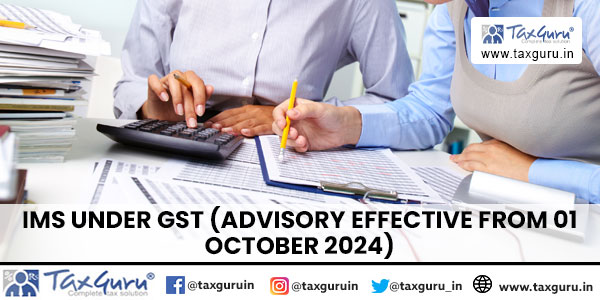The GST portal has introduced the Invoice Management System (IMS) effective from October 1, 2024, to simplify and streamline the process of reconciling invoices between taxpayers and their suppliers. This system ensures that taxpayers can accurately claim their Input Tax Credit (ITC) by matching their records with invoices uploaded by suppliers.
How Does IMS Work?
When a supplier uploads or saves an invoice in GSTR-1, IFF, or GSTR-1A, the details of that invoice are immediately reflected in the recipient’s IMS dashboard. The recipient can then take one of three actions:
Accept the invoice, making it eligible for ITC and including it in GSTR-2B.
Reject the invoice, excluding it from ITC eligibility.
Keep Pending, which defers action and the ITC claim to subsequent months.
Only invoices accepted by the recipient will be considered as eligible ITC in their GSTR-2B.

What Happens If the Recipient Takes No Action?
If the recipient doesn’t take any action on an invoice, it will be treated as deemed accepted and automatically included in GSTR-2B as an accepted invoice eligible for ITC. This ensures smooth processing even if the recipient forgets to act.
Timeline for IMS Filing
A draft GSTR-2B will be available to recipients on the 14th of the subsequent month, just like the current process. However, recipients can continue to accept, reject, or keep invoices pending in IMS even after GSTR-2B is generated up until the filing of GSTR-3B.
What About Amended Invoices by supplier?
If a supplier amends an invoice in GSTR-1A, the updated invoice details will be reflected in the recipient’s IMS dashboard. However, the amended invoice ITC will only appear in the recipient’s GSTR-2B of the subsequent month. Suppliers can also track the actions their recipients have taken on these invoices in the IMS.
IMS for QRMP Taxpayers ?
For taxpayers under the Quarterly Return and Monthly Payment (QRMP) scheme:
Invoices uploaded via IFF will appear in the recipient’s IMS dashboard.
GSTR-2B Generation:
For QRMP recipients, it will be generated quarterly.
For monthly taxpayers, it will be generated monthly.
Impact of Not Filing GSTR-3B of previous month?
If a taxpayer fails to file their GSTR-3B for a particular month, the GSTR-2B for the subsequent month will not be generated. This ensures compliance with filing timelines and prevents delays in ITC claims.
In conclusion, the IMS is a significant step toward improving compliance, ensuring accuracy in ITC claims, and providing clarity in the invoice reconciliation process for taxpayers. It simplifies workflows for both suppliers and recipients while maintaining robust controls to avoid discrepancies.





